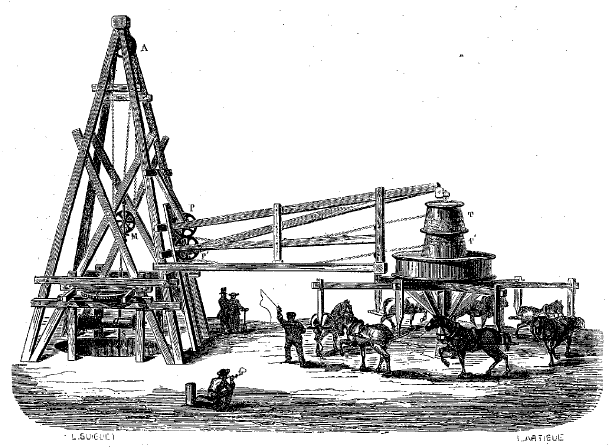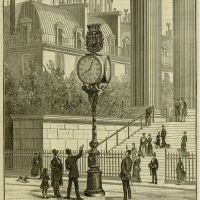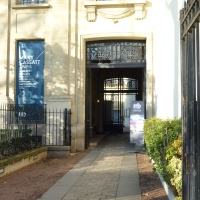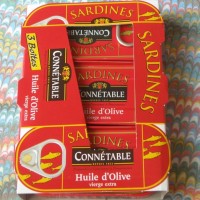The story begins in a photograph shop in the Village St-Paul. I was browsing among the stereograph cards, when I came across something that looked like this. It captivated me.
I say “looked like,” because this is not the same stereograph. For some reason, I did not buy the card I saw in the Paris shop, and I later regretted my hesitation. But I kept my eyes open, and a year or so later found the one above in a bargain pile at a photo show in Toronto. Sometimes I get lucky.
What was it? Where was it? The shop owner in the Village St-Paul had told me it was an artesian well that once stood on the Left Bank. That was all he knew. Later, I found a postcard that gave additional clues to its location.
The postcard was mailed in 1901. Look at the right side of the image. You can see the Great Wheel built for the 1900 Universal Exposition in Paris. Clearly, the tower was not far from the Champ de Mars, where the Exposition was held.
More and more intrigued, I went on eBay and ordered an illustration that had appeared in a magazine in 1888. Later I discovered it was based on an 1841 engraving.
Not your average artesian well. The iron tower rose to a height of about 13 storeys; the narrow base accentuated the sense of height. At certain times, visitors could climb the cast-iron circular stairs that wound up the middle of the column, stop on any one of the three circular balconies, and gaze out over the city and countryside. At other times, the tower was shrouded in diaphanous films of water that tumbled outwards and downwards from each of the balconies.
The tower was completed in 1841. But the story begins even earlier, in the days of Napoleon Bonaparte.
Throughout its history, Paris has made a clear distinction between what is inside the walls and what is outside, even though the location of the walls has changed over time. In the early 19th century, Paris had many slaughterhouses inside the walled city. Imagine the congestion, sounds, and odours as thousands of animals were walked along city streets to the slaughterhouses, where things got even noisier and smellier.
Napoleon Bonaparte considered this state of affairs unacceptable for his capital city. On February 9, 1810, he decreed that all the slaughterhouses in Paris were to be closed and replaced by five large new abattoirs outside the walls as they stood at the time. This was in the days before environmental assessments and impact studies, so work started about six weeks later. The abattoirs were finished in 1818, and as of September 15, 1818, it became illegal to bring animals for slaughter into the city. Alas for the exiled Napoleon, he was no longer in Paris to see the achievement of his decree.
One of the five abattoirs was called Grenelle; it was also known as the Abattoirs des Invalides or Abattoirs de Vaugirard. It was a massive complex with 16 buildings covering about eight acres, with its own water pipes feeding 174 taps. Abattoirs need lots of water, particularly one with 48 échaudoirs of scalding water.
Paris is geologically well-situated for tapping underground water supplies through artesian wells, a technology in which France had been a leader for centuries (the word artesian comes from the French province of Artois). In an artesian well, the underground water source is under such pressure that when the rock above is drilled through, water flows upwards of its own accord, with no pumping required. The greater the pressure, the higher it flows above ground level.
Some artesian wells tap water very close to the surface. Not the one at Grenelle. Drilling started in the abattoir courtyard. It was a risky business, demanding both faith and technical competence. The political driver was the mayor of Paris: at the time, one François Arago, now remembered more as a famous physicist. The engineering was entrusted to Louis-Georges Mulot, who had successfully drilled other artesian wells in France.
Drilling started in December 1833 and continued for years. In 1837, more than 200 feet of drilling rods broke loose and fell to the bottom of the bore hole, then at a depth of over 1,250 feet. It took 15 months to recover the equipment and resume drilling. Finally, at a depth of almost 1,800 feet, the boring-rod broke through the rocky arch above the subterranean aquifer, dropped about 14 feet and water gushed up through the pipes in the well and flooded the wooden tower housing the drilling equipment. Mulot sent a terse message to the Mayor on the afternoon of February 26, 1841:
Monsieur Arago, Nous avons l’eau. Mulot.
The next day 100,000 visitors came to see the gusher (not a bad turnout in the days before Twitter). Beautifully clear water was coming out of the ground in the middle of an abattoir. The water was under such pressure that it rose up more than 100 feet.
The water needed to be contained and piped to a reservoir from which it could be distributed to other parts of Paris. Such a system required a pipe that rose high above the ground near the well to let the water continue flowing at an even pressure.
Now at other times and in other cities, this would have been simply a matter of creating a functional piece of equipment to do the job on the spot. But this was a time of great pride in engineering, and besides, this was Paris. Anything that high had to be carefully situated and aesthetically pleasing. It was decided to erect the tower several hundred metres away from the abattoir in the centre of Place de Breteuil. And the design of the column was given to Constant Delaperche, an accomplished painter and sculptor who had been born in Paris in 1790.
The pieces of Delaperche’s design were cast in the foundry at Fourchambault and then brought to the site, where all 100,000 kilograms were assembled into a glorious iron confection that defies categorization. The top reminds me of a Wallace Fountain and the column seems pagoda-like, but in a rather straitlaced fashion.
Of course, some people complained about it, just as they did with Eiffel’s much taller tower. But the two are very different. Eiffel’s had been conceived as an exposition decoration and it eventually became the home of important scientific work; it is still an important communications tower. The Grenelle tower was also a major tourist attraction, but it had been built as a workhorse.
Mulot continued to drill other wells and won many awards for his work. He died in Paris on April 11, 1872, at his home on Rue de Rochechouart, aged 80. At the time his most famous well was still serving Paris; it was the tourist tower of the day. Eiffel’s came later.
But for all of its seeming timelessness, Paris changes. And seemingly endless supplies of water dwindle. In 1903 the Place de Breteuil lost its magnificent tower. It was replaced by a statue of Louis Pasteur.
The abattoir was also demolished and the area is now a residential district, but in 1906, the site of the drilling was honoured by the erection of a magnificent fountain, La Fontaine du Puits de Grenelle (the fountain of the Grenelle artesian well), in an intersection now known as the place Georges-Mulot, 15th arrondissement. Four medallions adorn the four-sided fountain, celebrating local worthies. In addition to Louis-Georges Mulot, we find Valentin Haüy facing rue Valentin-Haüy, Rosa Bonheur facing rue Rosa-Bonheur and Eugène Bouchot facing …well, you know the drill by now.
And once again, I am reminded that if our vision of a past era concentrates on the “one big thing,” we miss many equally exciting but different achievements.
Text by Norman Ball. Photograph of the abattoir courtesy of Paris en Images.
For more information on the artesian well, I recommend this site: Centenaire 1911-2011 des rues Lapparent-Vaudoyer-Heredia





























That was fascinating! Thanks for the historical detective work.
Dear Parisian Fields,
This is an amazing account of a beautiful tower, I am blown away by the water-fountain image….
So glad you took the time and love to record its history for us to enjoy.
A Big Thank You. Brunie, Long Island, NY
________________________________
Thank you so much for your kind comments and interest. Given the weather situation I hope that in the next few days you will not find yourself with more water than you want.
Ah, my word, ‘fascinating’ has already been used in a comment. But I read the post and that’s the word that came to mind. The subject and the way it was presented truly is and was fasinating. Thank you for the hard work and the elucidation.
What an astonishing story! That was really interesting – I am sure I have walked past that fountain without realising the history of the site.
Pingback: The Paris Blog: Paris, France Expat Tips & Resources »Blog Archive » The Other Great Tower
Pingback: Il flotte mais ne sombre pas | One quality, the finest.
https://www.facebook.com/pages/Gaston-Tissandier/350172435106311
Mais pour les pilotes aeronautes, c’est un grave hasard !